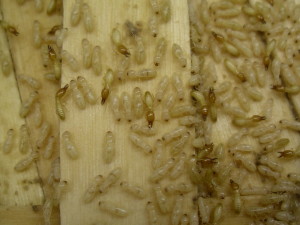 |
March 2015 Newsletter |
Formosan Termites
There are three main types of termites that can cause problems for homeowners in Central Texas- native subterranean termites, formosan subterranean termites and drywood termites. This article will focus of formosan termites.
Formosan termites are a more voracious type of subterranean termite. These termites have been spread throughout Texas through transport of infested material or soil. Formosan termites build carton nests that allow them to survive above ground without contact with the soil. Nests are often located in hollow spaces, such as wall voids.
Formosan subterranean termite workers and soldiers.
Formosan termites feed on a wider variety of cellulose than other subterranean termites, including live plants, consuming both spring and summer growth wood whereas native subterranean termites feed only on spring growth. Formosan termites have also been known to chew through non-cellulose materials such as soft metals, plaster or plastic.
The type of termite is determined by using soldiers (the group that defends the colony) or alates (winged reproductives) for identification. Formosan termite soldiers have a hardened head capsule that is tear-drop shaped. The alates have two heavy veins on the leading edge of the front wing along with hairs on the wings. If you suspect termites, you can submit sample insects to me for identification. Treatment would need to be carried out by a profession pest management company.
For more information or help with identification, contact Wizzie Brown, Texas AgriLife Extension Service Program Specialist at 512.854.9600. Check out my blog at www.urban-ipm.blogspot.com

